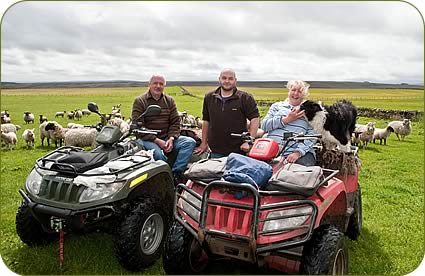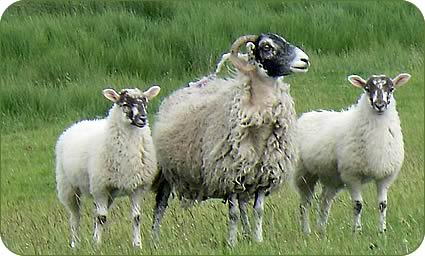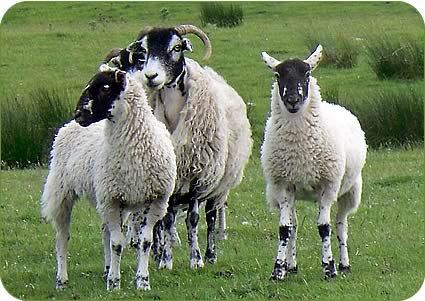Jennifer MacKenzie is an agricultural photo journalist with almost 30 year's experience. Operating from her base in Cumbria, Jennifer undertakes mainly industry-related freelance writing and photography.
Sheep and conservation go hand in hand
Swaledale and North of England Mule sheep and conservation go hand in hand
at Branchend Farm, Langley, near Hexham.
Long winters on the farm which
runs at between 1,000ft to 1,200ft above sea level impacted on the profitability
of keeping cattle for David and Linda Murray so in 1993 they began to concentrate
on sheep.
“Traditionally, we were running Swaledale ewes and we wanted to keep
a Mule flock but because we had to house the cattle from mid October often
until late into May we didn’t have the sheds to lamb Mules with twins
inside,” said David.
“We worked out our profit margins and decided we would be better
off with sheep than cattle. We wanted to keep it traditional though,” he
added.
 |
| David, Callum and Linda Murray at Branchend Farm |
The tenanted farm runs to 500 acres of inside ground with around 400 acres
hefted on neighbouring Allendale and Hexhamshire Common, where the Murrays
are one of 22 graziers on the open fell.
An all sheep enterprise was also then favoured for entry into environmental
stewardship, a natural progression for the Murrays who have for years worked
with the RSPB in monitoring and encouraging numbers of birds on the farm,
including black grouse, plover and other wetland birds.
The Murrays have carried out rush management for a number of years to improve
nesting habitats for birds and as a result have lapwing, curlew, redshank
and snipe nest on the farm.
The farm carries a flock of 400 registered Swaledale ewes, half of which
are bred pure to produce flock replacements, and the remainder crossed
with the Bluefaced Leicester to provide gimmer lambs for the North of England
Mule flock of 500 ewes.
The Mules are crossed with the Suffolk and 100 of the crossbred progeny
are put to the Beltex as hoggs.
Management of the sheep is very much a partnership for the Murrays - so
much so that they have ‘his and hers’ quad bikes!
Linda looks after the outside feeding and she does the lambing inside.
David does most of the shepherding as well as looking after getting in
the silage and haylage crops. He also markets the lambs at Carlisle on
a Monday.
 |
| Swaledale ewes with Mule lambs |
During the summer, 200 of the Swaledale ewes are on the fell. This number
is reduced in the winter to 120 to comply with the UELS and HLS environmental
scheme agreements which cover the whole farm.
The sheep are fed before and after lambing time which begins on March 29
with the Swaledales crossed with the Bluefaced Leicester and most of the
Mules. The Swaledales which are bred pure and the hoggs begin lambing on
April 24.
Those carrying twins and triplets are lambed inside and turned out as soon
as possible. The Murrays prefer the Swaledales which are pure bred to produce
just one lamb while the Mules last year had a 193 % lambing.
Lambing tends to be a family affair with eldest daughter Shelley, who is
married and lives in Annfield Plain, daughter Dominique who lives in Reading
and son Callum, who is studying for a degree in computer engineering at
Liverpool University all coming back to the farm to lend a hand.
All triplets generally are taken off their mothers and run as pet lambs
to prevent damage to the ewes and the risk of mastitis. The pets are reared
on a Shepherdess bucket system and weaned by five to six weeks old to keep
milk replacer costs down.
The firsts lambs are sold straight off their mothers in mid August last
year selling at £70 a head through Carlisle to peak at £108
in the prime ring to be regularly in the leading prices for Suffolk-sired
lambs out of Mules. They are usually 42-44kg.
Some are sold store are sold store after early September through to March
and these averaged around £60 a head last year. Mule and Swaledale
wether lambs are usually sold on the hook and early this year the tail
enders averaged £95 a head, with 32 out of 69 making over £100
apiece.
 |
| Swaledale ewes with Mule lambs |
The Mule-Suffolk cross hoggs have a 100% lambing and their lambs are sold
finished by November-December making £80-£85 a head at just
over 40kg, aiming for both the home and export markets.
While currently all the Mule gimmer lambs are kept as replacements, some
may be sold in the future.
Commercial Suffolk rams are bought mostly at Carlisle and some at Hexham
with traditinal crossing type Bluefaced Leicesters bought at Lazonby and
recent purchases from Messrs Coulthard at Davygill have produced particularly
good gimmer lambs.
The flock has been closed, apart from the purchase of stock rams, for the
last three years to avoid price fluctuations in the breeding sheep market.
Swaledale rams are sold at St John’s Chapel as shearlings and stock
rams are bought at Kirkby Stephen or Hawes marts with investments of up
to £4,000 being made. The flock is gradually being built back up
the quality it was prior to it being taken out during 2001’s foot
and mouth epidemic.

